Snow-capped peaks, dizzying slopes, harmonious and perfect shape: Mount Fuji. Breathtakingly majestic, a famous cultural icon: a mystical and spiritual place. There are no words to describe what it feels like to be in front of this wonder of nature. Its importance is such that it is often said that, more than a symbol of Japan, it is Japan.
Mount Fuji 富士山 The symbol of Japan
Guest Author: Flavia
Fuji (富士山 Fu-Ji-San) is located in the Chūbu region (中部地方), about 100 km southwest of the capital Tokyo. It lies between the current prefectures of Yamanashi and Shizuoka, with Kanagawa prefecture to the east. The entire area is part of the Fuji-Hakone-Izu National Park (富士-箱根-伊豆-国立公園Fuji-Hakone-Izu Kokuritsu-Koen). Together with Mount Tate (立山) and Mount Haku (白山) is part of the CDs. Three Sacred Mountains ( 三霊山 San-Rei-Zan ) so identified because they are sacred to the Japanese tradition.
The numerous cultural-historical sites around the mountain testify to the great spiritual significance that has always been attributed to it. In pre-modern times it was, in fact, a pilgrimage destination for monks engaged in spiritual research and self-discipline, as well as for ordinary people.
Today this religious connotation has been lost. Although the idea is still widespread that climbing to the top of Fuji at least once in a lifetime is almost a religious duty. Nowadays, climbing is also facilitated by modern means, thanks to which the route to be made on foot is more than halved!
Source of inspiration for a vast cultural production (literature, poetry, art…), its influence has reached the West. It is now well known how much the prints of the masters Hokusai and Hiroshige, portraying Fuji, influenced Monet and Van Gogh.
The fact that it appears among the yen bills and in the name of the main television station is indicative of the central role it plays for the people of the Rising Sun. So much so that it is classified as a “Special Site of Scenic Beauty” and protected as cultural property by the Agency for Cultural Affairs (branch of MEXT). In 2013 it is declared World Cultural Heritage by UNESCO. It is included in the category culture – rather than nature – because its impact goes far beyond its natural essence. There are at least twenty-five sites of interest recognized by UNESCO, on Japan’s most important mountain.
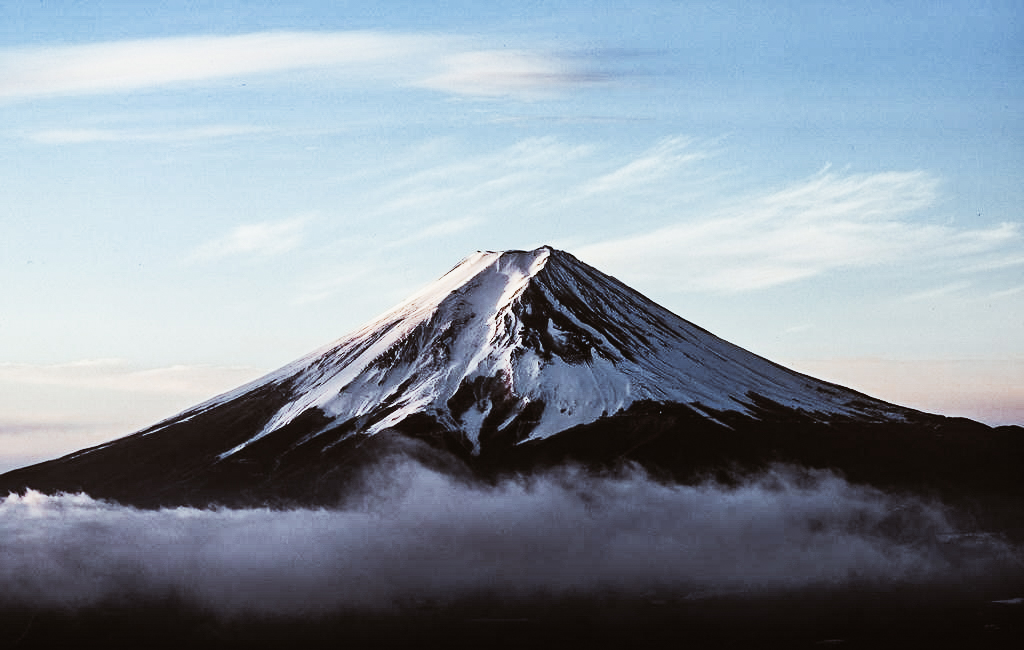
photo credits: expedia.it
Fuji Geological History
Fuji is classified as a stratovolcano, a volcano formed by the accumulation of layers of solidified lava and volcanic ash. Its particularly steep slopes, its perfect conical and symmetrical shape are the results of this overlapping process. It has a crater with a diameter of about 600 meters, 250 meters deep, and at least 70 small secondary peaks including Mount Hōei and Omuro. Its volcanic activity began more than 100,000 years ago.
It was long agreed that there were three stages of the stratification process, called “Small Peak” (小御岳Ko-Mitake), Old Fuji (古富士Ko-Fuji ) and New Fuji (新富士Shin-Fuji). Since 2004 new studies and explorations have revealed the existence of a fourth phase Proto-Komitake (小御岳 Sen-Komitake). It is currently believed that the Komitake originated as a result of eruptions produced by the Proto-Komitake hundreds of thousands of years ago. Just as about 100,000 years ago an eruption of the Komitake gave rise to Old Fuji, the summit of which reached about 2,700 meters with subsequent eruptions. So the Fuji over the millennia has been gradually shaping itself. It reached its present form about 10,000 years ago, after Old Fuji and Komitake also disappeared under the layers of lava.
It erupted nine times between 781 and 1083, and then it remained quiet for a few centuries. Its last eruption – which formed Mount Hōei – dates back to 1707, which for a while led to classify it as dormant. But around 1960 there is a change of definition: it is defined as “active” every volcano whose eruption has ever been documented. In 2003 a further update extends the definition to every volcano that has ever erupted in the last 10,000 years and that continues to give signs of activity. Under these last two designations, Fuji is now considered active. It ranks at 5 in the Volcanic Explosivity Index on a scale from 0 to 8 (like our Vesuvius and Etna).
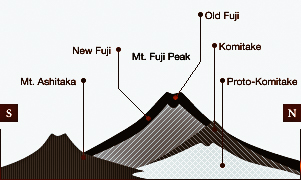
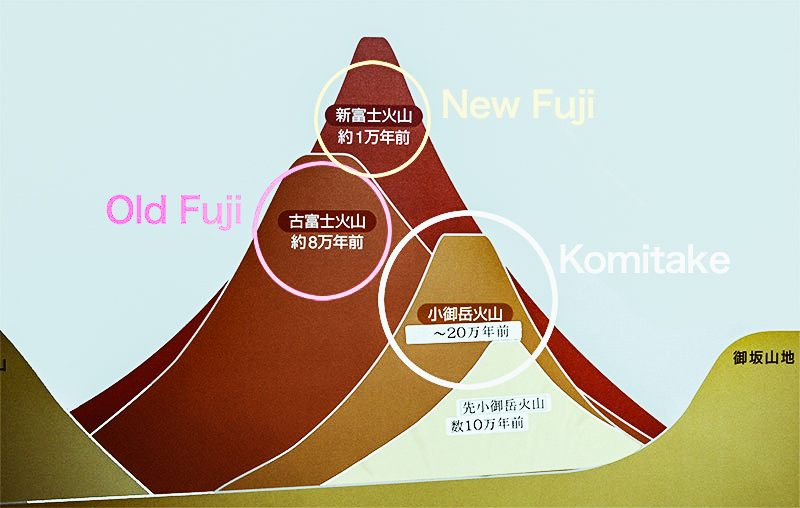
photo credits: web.archive.org
Geography and territory of Fuji San
Thanks to its 3,776 meters of height, our Fuji is undisputed as the highest peak in Japan. However, between 1895 and 1945 it was climbed by another mountain! How? Because of the post-war agreements closing the first Sino-Japanese conflict, with the Treaty of Shimonoseki, when Taiwan came under Japanese control. Therefore, formally, in those years Taiwanese territory was Japanese. Thus, the Taiwanese “Jade Mountain” (玉山 Yu-Shan) – then called by the Japanese “New High Mountain” (新高山Nii-Taka-Yama) – with its 3,952 meters manages for 50 years to overtake Fuji-San.
There are three towns on its slopes (whose names also characterize three of the main access routes to Fuji): Gotemba (御殿場) to the east, Fujinomiya (富士宮) to the south-west, Fujiyoshida (富士吉田) to the north.
Five, the lakes (富士五湖 Fu-Ji-Go-Ko) that surround it: Yamanaka (山中湖); Kawaguchi (河口湖); Saiko (西湖); Shōji ( 精進湖 ); Motosu (本栖湖). Curiosity: the latter in particular would be the Japanese version of Loch Ness. Legend has it that in 1970 they sighted a creature of 30 meters with rough skin and full of humps: it was promptly christened Mossie!
Near the lakes, to the north-west, we also find a forest of 3000 hectares: Aokigahara (青木ヶ原), also known as Jukai (樹海) or “sea of trees” (sadly known for the primacy of suicides, second only to the Golden Gate Bridge in San Francisco). The area is also rich in caves and hot springs.
Mishotai (御正体山) and Shakushiyama (杓子山) in the northeast, Kurodake (黒岳) in the north and Kenashi (毛無山) in the west, are the closest peaks from which you can see Fuji in the front row.

photo credits: itinari.com
Fuji, etymology and meanings: But what does “Fuji” mean?
The first thing to note: the name “Fuji” already existed before the introduction of Chinese ideograms or sinograms. The characters used to indicate it were therefore chosen according to their pronunciation so that the latter would coincide with the pre-existing pronunciation. Written as it is today, i.e. 富士山 (Fuji-San), it is given the meaning of “Prosperous Mountain”.
There are, however, different opinions that in the past “Fuji” meant something else. Everything always depends on the writing: the same pronunciation can correspond to more than one meaning. Ergo more words, distinguishable at that point from the writing (as well as the context).
Here are the most popular theories about the meaning of Fuji:
- Unparalleled Mountain【不二山】: very popular is the theory that the name of the volcano was originally written with these Kanji-ideograms- to mean “Unrivaled Mountain” (二 is the number two, so “not two”).
- Monte dell’immortalità【不死山】: This interpretation is based on three works of the past: the ancient Chinese chronicles “Shiki” (史記), the Taketori Monogatari (竹取物語) and the Fuji Sanki (富士山記). The first reports the existence of an elixir of immortality on top of the volcano; the third describes the mountain as the home of immortal beings. The fire of Fuji so metaphor of the inexhaustible “fire” of life. The Taketori Monogatari suggests another etymology, however, that of “mountain rich in warriors” (富 = abundance, 士 = warrior).
- Winterless Mountain【不尽山】: Many people bring back such “inexhaustible being” to the snow because the summit is almost perpetually covered with snow.
These are still theories but, I must say, this last interpretation would be quite precise. Personally I do not disdain even the alternative of the “Mountain without equal”, it is certainly right!
The misunderstanding “Fujiyama”
Speaking of Fuji names, it seems necessary to open a parenthesis on the issue “Fujiyama”. If only for those who do not know the language. Since it has escaped the pen of its first transcriber, you might also come across this term in some tourist guides. Well, this is a linguistic misunderstanding! An error dating back to the first transcriptions from Japanese to Western languages.
The character 山, which indicates the mountain, is pronounceable with the Chinese reading “san” but also with the Japanese reading “yama”. The Chinese reading (on’yomi) is clearly due to the fact that the ideograms come from China. The reading of Chinese origin is mostly taken when you have compound words, otherwise, the Japanese one (kun’yomi) is used. The exceptions are not rare, but Fuji is not among them.
That’s why using “Fujiyama” as a translation of “Mount Fuji” (富士山) is an error. 山 ” 山 ” alone can be read “yama”, but next to the name “Fuji” takes the pronunciation “san”. Therefore, “Fuji-San” is the only correct pronunciation for 富士山 [Mount Fuji].
If ever, the form “Fuji no Yama” (富士の山 “Fuji mountain”) would be admissible since 山 and 富士 are divided by the specification particle の. Actually there is also this expression, but it is obsolete, found in ancient literary works. Some also recognize the possible contraction of this rare term from “Fuji no Yama” to “Fuji-Yama”. Even if it was, the eventual absence of the particle の assumes the presence, however, as much as it is understood. This is not the case in the wrong transcription “Fujiyama”, where nothing is contemplated between “Fuji” and “Yama”. Then, the latter is always an error.
Other courtly or disused versions are:
- Fu-Gaku (富岳 “Abundant Top”);
- Fuji no Takane (富士の高嶺 “High peak of Fuji”);
- Fuyō-Hō (芙蓉峰 “Lotus Summit”).
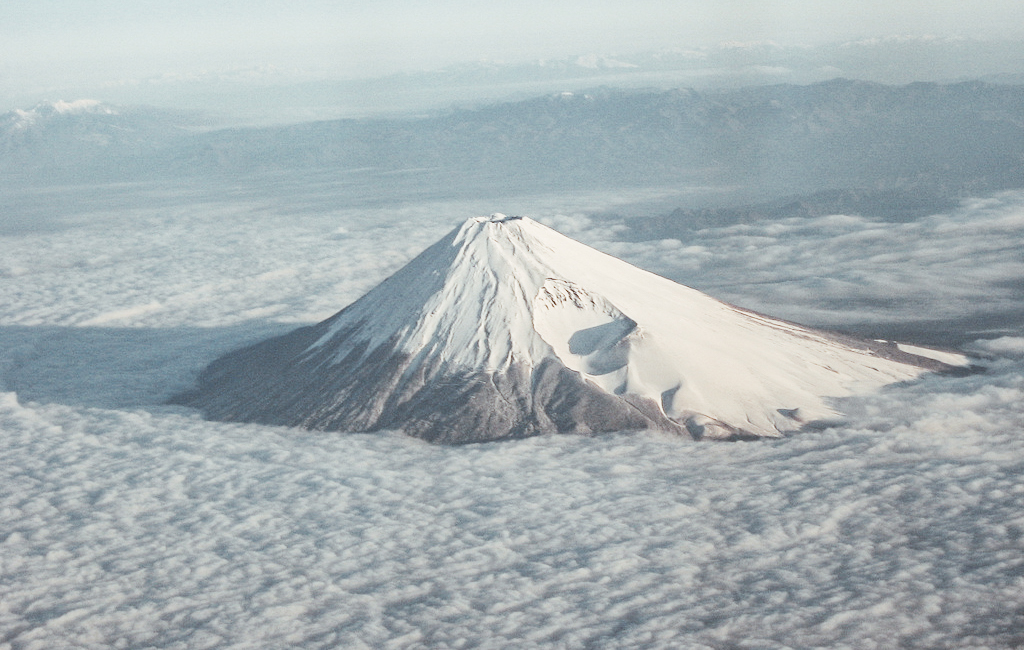
photo credits: kyuhoshi.com
The sacredness of the mountains in the Japanese tradition
Mountains and volcanoes have always had a special place in Japanese spirituality, which has given them a special meaning since the beginning. They are seen as mysterious places, home to spirits as good as bad. A mountain or a volcano is definitely a special, sacred place. A deity, or the seat of one or more gods, perceived by the people as the protector of the whole community.
This autochthonous sensibility – pre-existing to Buddhism – was a form of shamanism that resulted in those beliefs and practices that constitute Shintoism. Shintō made nature an object of worship as an earthly manifestation of the Kami (神 Divinity). Not only the mountains but also the rocks, trees, rivers and waterfalls, lakes…all are perceived as the earthly expression of the Kami. Fuji for example is also defined in Shintō as “Yama no Kami” (山の神).
This Shintō practice of mountain veneration is part of the Kannabi Shinkō (神奈備信仰 “Kannabi Faith”). Kannabi” are all those sacred places used to celebrate and give thanks to the Kami; in the case of mountains, the gods or spirits of the mountain.
This autochthonous conception is then intertwined with the Buddhist vision of the mountain as an ascetic place for the search for enlightenment and the realization of Buddhism; the Taoist one, of the mountain as a mystical place, of Yin-Yang harmony and the five elements; the Confucian one, of the mountain as a cosmic place that connects all living beings in the common search for harmony and self-realization (not in a selfish sense, of course).
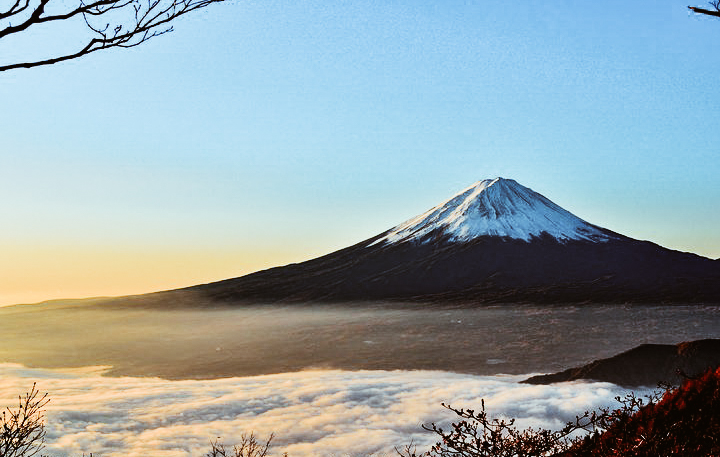
photo credits: tripadvisor.com
The ancient faith Fuji: why worship a mountain?
The question is very simple but full of meaning. The Japanese have always looked at Fuji – at nature in general – with the eyes of a child, I dare say. With attention to its behaviour, reacting and adapting their actions accordingly. To begin with, and before anything else, this “looking”, alone, is distinctive of the type of approach that distinguishes these people. Then comes into play as they have observed, that is, with attention. Which brings us to step three: their response after what they have caught. An answer as pertinent as the initial, careful, observation. An answer that communicates nothing else but the acknowledgement “I have recognized you, I have recognized your existence; I respect your will”. Only a careful perception could lead to this kind of response.
So think of Fuji, so imposing, so perfect…and so explosive in ancient times: the ancient Japanese could only be impressed by such a manifestation. The first settlements of which there are traces are very ancient: they date back to a period between 11,000 and 13,000 years ago, called Jōmon Incipiente (very first Japanese prehistoric era). Well, among other things, stones have been found, whose arrangement indicated unequivocal ceremonial signs!
Its power, together with its grandeur, led the ancient Japanese to fear it and admire it at the same time. They came to the conclusion that that volcano so powerful had to be the expression of a deity or just a deity (神Kami). For obvious reasons, they tended to consider it a deity of fire. So the Fuji began to be worshipped with the intent to avert its eruptions, inevitably interpreted as the wrath of the deity present there.
The nature of this ancient autochthonous faith remains, in any case, a little mysterious, but it should not be surprising. After all, we are talking about really ancient times.
Fire and Water: the dualism of Fuji-Kami
.
One thing, however, that can be seen with more confidence is that double attitude/reaction of admiration and fear on the part of the ancient Japanese. Despite its smoky character – pass me the term – of the time, Fuji was not perceived as a mere intractable or evil divinity. It was simply what it was. And the Japanese ancestors also considered its positive aspects…almost all of them converging in a single word: water.
In ancient times the water of Fuji has in fact represented an important source of sustenance for the inhabitants of the surrounding areas as well as for the fauna and flora. Suffice it to say that the abundance of water – and food – was considered a valid reason to want to continue living near the volcano, despite the danger it represented.
Even today the abundant rainfall and snowfall that is poured every year are decisive for the maintenance or formation of rivers and springs underground. And even today the water of the mountains – and the mountains themselves – are seen as a source of fertility (think of rice crops). Moreover, the water of Fuji was also considered sacred, so much so that it was later used for ablutions and purifications for religious/spiritual purposes.
Fuji was therefore seen in a twofold way as fire and water-vulcano and spring, divinity of fire and at the same time source of purification. Fear and respect for the power of the volcano: simply two sides of the same coin. Duality, in truth, is a characteristic of this people (it is found in history, in language…). Apparently, not even Fuji is exempt from it!
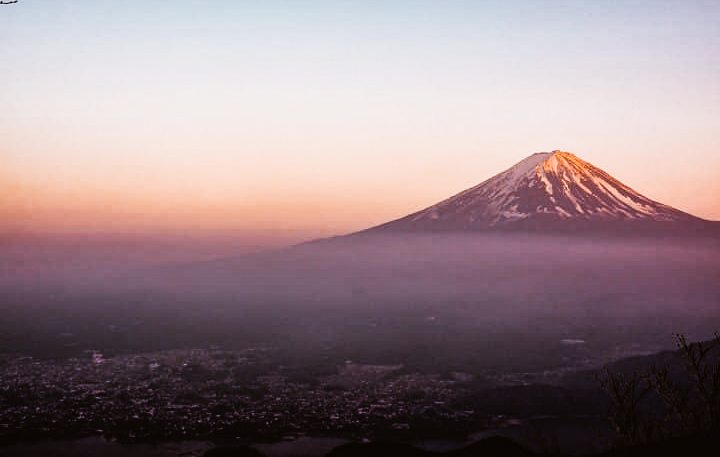
photo credits: matcha-jp.com
Sengen-Asama Sanctuaries
The wrath of the divine-Fuji was very frequent between the end of the 8th and mid-10th century. Thus, around the ninth century, the sanctuaries dedicated to it began to sprout like mushrooms, not only on the slopes of the volcano, but throughout the archipelago. We talk about Asama or Sengen (浅間) sanctuaries when it comes to the god of Fuji (浅間の大神Asama/Sengen no Ōkami). The terms Asama and Sengen are only two different readings of the same word. However, while “Asama” can also be found in other mountains, “theengen” ends up identifying all the Fuji sanctuaries of worship, particularly those on its slopes.
It is often read that the Kojiki (古事記) – “Tales of ancient events” – associates the divinity of Fuji to the figure of the goddess Kono Hana Sakuya Hime (木花咲耶姫). According to the myth, the goddess “Princess who makes the trees bloom” is said to descend directly from Izanami and Izanagi, the original creator gods of the Japanese archipelago. While it is true that the oldest Japanese narrative collection narrates about Sakuya-Hime and her father, the god Oyamatsumi (大山津見神 “mountain goddess”), the association to Fuji is not so obvious. In fact, the historian Byron Earhart – among the main sources of this article – warns that this link is actually recent. And that the Kojiki, in fact, would not make any direct connection between Fuji and the goddess.
In any case, it is in such Sengen sanctuaries that those rituals to prevent catastrophes caused by the volcanic god Sengen-Asama take place. In order to calm his anger, he is even given the title of Myōujin (明神 “Illustrious Kami”) or “Illustrious Gods”. The rituals consisted of rites of pacification and thanksgiving, accompanied by the reading of Buddhist sutras.
In this phase of the cult, however, Fuji is not yet climbed but rather venerated from afar. This is certainly due to the fact that around the 11th century its volcanic activity was still unstable. It is only with the inclusion of Esoteric Buddhism in this framework – and with the end of the eruptions – that religious pilgrimages will begin.

photo credits: livingnomads.com
Shugendō: where Shintō meets Buddhism
You can’t talk about Fuji without talking about Shugendō. It is in fact this practice that significantly increases the popularity of Fuji through asceticism. Shugendō (修験道 “Via della Pratica Ascetica”) is the encounter between Shintō tradition and Esoteric Buddhism. A hybrid between native shamanic practices and Buddhist rituality. This “hybridization” consists as much in a mix of elements of each tradition as in a coexistence of the same (some Shintō elements, for example, remain well intact).
The Shugendō takes shape towards the end of the Heian period (794-1185) but the “mountain” Buddhism of the Saichō and Kūkai ascetics of the Nara period is its precursor. As we know, around 1083 Fuji ceased its intense activity. Since then it began to be identified as a place of “apparition of the Buddhas”: a place for all those seeking a spiritual path. This path is also understood in the true sense of the word, as witnessed by the spiritual pilgrimages that are becoming more and more a “phenomenon”. The practitioners, mainly known as Yamabushi (山伏) or Shugenja (修験者), included different types of ascetics in addition to actual monks.
Its origins can be traced back to the semi-legendary figures of Prince Shōtoku (who would have inspired the above mentioned Saichō) and the mystic-ascetic En no Gyōja or En no Ozunu. Legend has it that both the prince and Ozunu reached Fuji in flight – just in Taoist magician style (仙人 Sen-nin). En no Ozunu is remembered as the legendary founder of Shugendō, the one who would bring rituals and ascetic practices to the mountains.
Shugendō is key because he elaborated and developed the mountain practice born in the Nara era, bringing it to Fuji. And making the latter popular as a place of spiritual asceticism. A fundamental element that characterizes it are the ascetic experiences of its main exponents and the insights they receive from it, determining the syncretization between Kami shintō and Buddhist divinities.
Murayama Shugendō, Matsudai and Raison
If En no Gyōja is the “legendary” founder of Shugendō, more historical are instead Matsudai (end Heian) and Raison (presumably end Kamakura). The two ascetics, which constitute the Shugendō linked to Fuji.
Matsudai, the “Saint of Fuji” (富士上人 Fuji Shōnin) – according to the chronicles the first to climb the mountain – is the one who inaugurated it as a place for ascetic practices. In 1149 he would in fact erected on its summit a first form of a temple dedicated to Dainichi Nyorai (大日如来 the “Great Sun-Buddha”). Thus operating a first syncretism between the divinity of Esoteric Buddhism and Sengen-Asama Ōkami. However, since, then as now, the conditions up there are impervious almost all year round, Matsudai places the base of the neo-movement on the slopes of the mountain. Precisely, in the village of Murayama (today’s Fujinomiya)- hence the name “Murayama Shugendō”. A complex of temples begins to rise all around the mountain. Since then, Murayama Shugendō becomes a movement of such magnitude that it exerts full control over the mountain (even collecting “tolls” for access to the summit).
But if Matsudai is the forerunner, it is the monk Raison who gives the movement a truly organized structure. Through the network of temples, religious practices and paths – “inaugurated” under Murayama -, Fuji becomes institutionalized.
It is said that Matsudai gives the movement the vertical structure while Raison the horizontal one. Raison opens the ascetic practice on the mountain also to ordinary people, establishing contacts with the so-called lay ascetics (行人 Gyōnin) and leaders of local groups. This already marks a small difference from Matsudai, at that time the movement was more linked to the court and the imperial family (and later to the feudal dominated class).
Raison’s work is thus a forerunner to subsequent mass pilgrimages, but it also carries within itself the seed of the decline of the movement. Accomplice the advent of the Sengoku era, with the increase of flows towards the mountain, at a certain point Murayama Shugendō will no longer be able to control all the routes. The killing of the daimyō of Suruga, on which the movement rested, will be the final blow that will mark the sunset of Murayama.
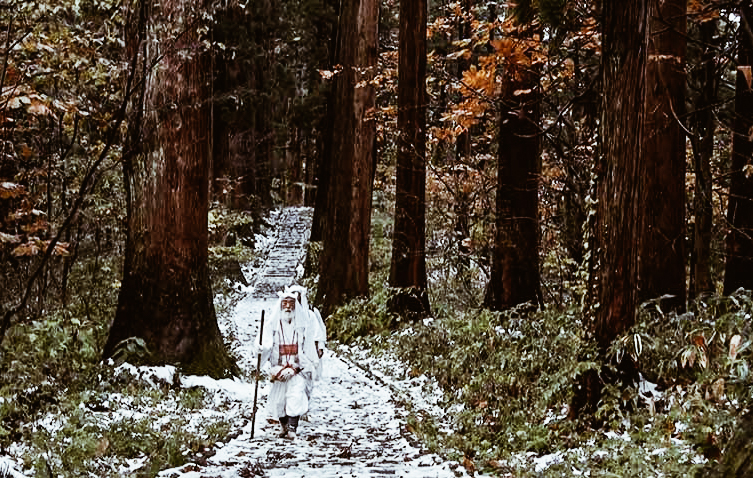
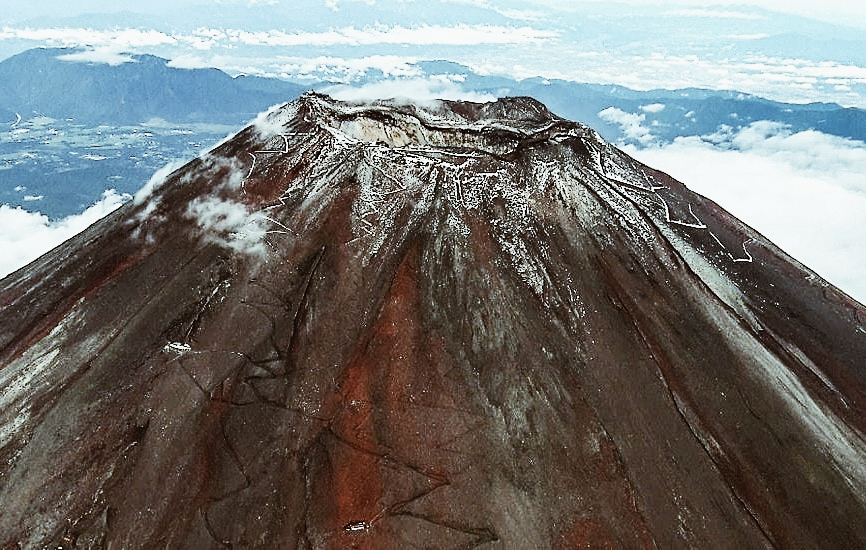
photo credits: yamabushido.jp, mundo-nipo.com
Fuji-Ko ( 富士講 ), Kakugyō and Miroku
It is, therefore, the interweaving with politics and the ruling classes that drags down the Murayama Shugendō. Also because, the new times required new responses to the new historical paradigms that were occurring. We are in the Sengoku era (戦国), the hard era of the Warring States: an era marked by hunger, general disorder and terrible battles, where nothing was stable. In the context of these dramas, people needed new answers. It is at this juncture that those religious groups known as Fuji-kō originated (富士講). “Confraternities” that were inspired by the popular cult inspired by Fuji and that identified Fuji as their place of worship. The emphasis on the inclusion of all social classes is what distinguishes Fuji-kō from Murayama Shugendō.
It is in this frame that the figures of Kakugyō and – a little later – Jikigyō Miroku (1671- 1733) come into play. Kakugyō with his activity further increases the fame of Fuji, making many ordinary people come to the mountain, going to form such associations (講). Miroku does the same thing, however, with a ritual suicide act on the mountain, which puts Fuji even more in the spotlight. For this reason, both of them are considered inspiring the popular Fuji-kō cult.
The experience of Kakugyō circumvents the Murayama tradition, becoming separate from that of Matsudai and Raison. The revelations he would first receive from the spirit of En no Gyōja and then from the syncretized divinity of Fuji Sengen-Dainichi are fundamental. He would have been revealed that Mount Fuji and its divinity would be the source of all that exists. That all the suffering of that period was due to an imbalance between heaven and earth. And the way to remedy it, that of unifying the Fuji faith in a “cosmological” system of beneficial practices open to all people. From this follows the mission of Kakugyō, to unify practices and beliefs related to Fuji as the basis of the popular cult of Fuji-kō.
The activity of Kakugyō is characterized by purifications and ablutions in the lakes around Fuji. As well as the ascetic practices in the Hitoana (人穴), the caves of the volcano indicated by the essence of En no Gyōja in the first revelation, where he would then “come into direct contact” with the Sengen-Dainichi.
Fuji Mandala
Yes, even in Japan there were mandalas! Originally from India, and passing through China, through Buddhism they also came to the Land of the Rising Sun. We want to remember them, because they were a characteristic and functional tool for Esoteric Buddhism of the Muromachi era. His practitioners used them to reach the understanding of Cosmic Truth and as a support during meditations.
Such mandalas represented the universal order of things-the essence of which is Buddhism and the relationship between it and its earthly manifestations. To embrace this truth in words alone was not considered sufficient and, for this reason, it was recognized in iconographic language as the best way to internalize it. The image, more than the word, seems to be the preferred tool of this people to get in touch with the essence of things. After all, even ideograms, what are they if not images?
Specifically, the Fuji mandalas represent the ambivalent path of the pilgrims – that is, the geographical and spiritual path they decided to take. Typical of this era, the representation of the three peaks of Fuji associated with the triad of Buddhist deities Dainichi, Yakushi and Amida (as well as the Isshin Sangan doctrine 一心三観). So popular was it, that the three peaks became a custom of Fuji iconography. Without prejudice, of course, to the normal variations characteristic of all times.
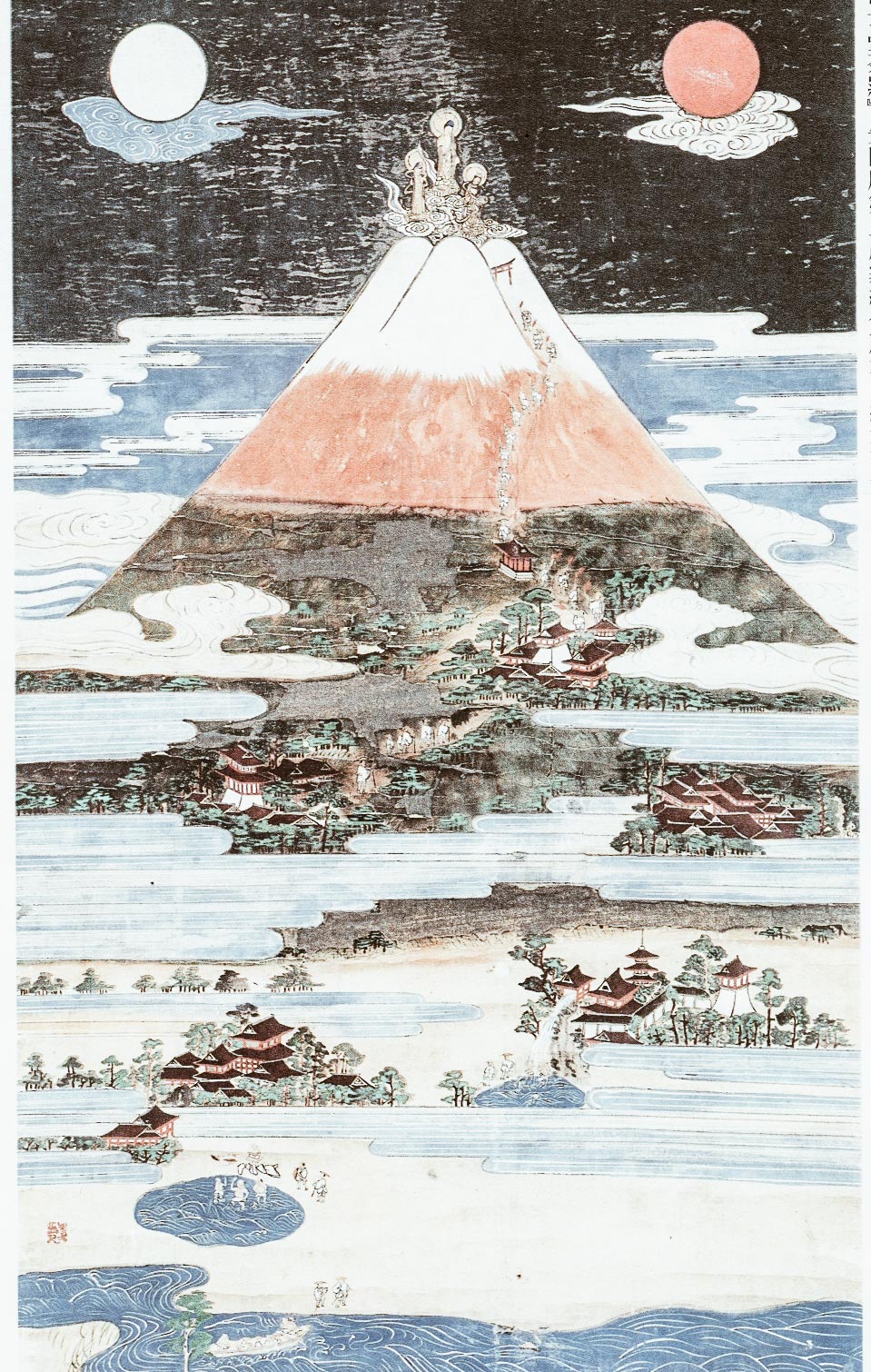

photo credits: medium.com/@jamesinjapan/
Meisho (名所): the Fuji in the arts
The meisho (“famous locality”) are those places sculpted in the collective imagination because they were made famous by the Japanese arts. They are a reflection of that special relationship with nature from which the Japanese have always drawn inspiration. Nature is associated with moods and the image is the best way in which this people can give voice to their innermost feelings. Seasons, rhythms and colors of nature, places…become so essential, in their specificity, to express moods otherwise difficult to describe in words. The attention to nature is thus expressed through an aesthetic sense that transcends the very representation of the “object”.
This tendency can already be seen in the Nara period (8th century), when the written tradition had not yet fully established itself. It is from this period the poetic anthology Man’yōshū (万葉集 “Collection of ten thousand leaves”). The Man’yōshū speaks of Fuji as a “mysterious” god, with “burning fires”; he paints it as an ideal mountain and highlights its importance as a protective deity. That one of the very first written works speaks to us immediately about Fuji is indicative. It means that the mountain was somehow “installed” in the collective imagination, like meisho, even before the passage to the written tradition! And this even though at that time it had not yet emerged as an absolute icon (although kami, it was still “only” one of the many existing sacred mountains).
Around the thirteenth century it began to become markedly more protagonist. In the Muromachi period it became central both as a religious subject (as in the Fuji Mandalas) and as a purely landscape icon (ink paintings in Chinese style). Among these, the “Eight Fuji Views” marked the beginning of Fuji’s serial representations, inspiring in the Edo period the masterpieces of the masters Hokusai and Hiroshige.
Other famous works in which Fuji appeared: Literature Taketori Monogatari (竹取物語) and Ise Monogatari (伊勢物語) both from the 10th century; novels by contemporary writers Natsume Sōseki and Dazai Osamu. Visual Arts The 11th century Shōtoku Taishi Eden/Emaki paintings on roll; the Ukiyo-e woodcuts by Hokusai and Hiroshige from the 18th-19th centuries; and, of course, photography and cinema in modern times.
Climb Fuji to the present day
There are four possible access routes or routes to the summit. In ascending order of altitude:
- 1450 m, path Gotemba – the longest of all, without medical care centers, is not very popular;
- 2000 m, Subashiri trail – less popular and, perhaps because of this, devoid of medical care centers;
- 2300 m, Yoshida trail – the most popular, because it is easier and full of services (shelters, medical centers…) so ideal for beginners too;
- 2400 m, Fujinomiya trail – the shortest but also the steepest ever, has a medical center and is on average crowded.
All four start from 5ᵃ station (the term “station” indicates the level of difficulty of the climb): from 7ᵃ to 9ᵃ, the last one, the level is maximum. Between ascent and descent the total time is about 10-12 hours. It is therefore necessary to plan, and keep in mind that part of the ascent will be done at night. In fact, if you want to be present at the sunrise show – destination of almost all visitors – the advice is to calculate well the time in order to reach the refuge between 16.00 and 19.00. To rest until midnight, and then continue the climb for about 4 hours arriving at the top right, right for the dawn (at 4.30!).
The official climbing season runs roughly from the beginning of July to the end of August (maximum, until mid-September). Various Shintō ceremonies open the access to Fuji on July 1st and end with a big torchlight procession to the Yoshida sanctuary on August 26th. To venture outside of these dates is possible…but strongly discouraged! Since the climate is always severe and moreover, out of season, the shelters remain closed. In fact, every year, unfortunately, there are deaths, whether from avalanches, slippage, or frostbite… therefore, unless you are superman, don’t go there out of season!
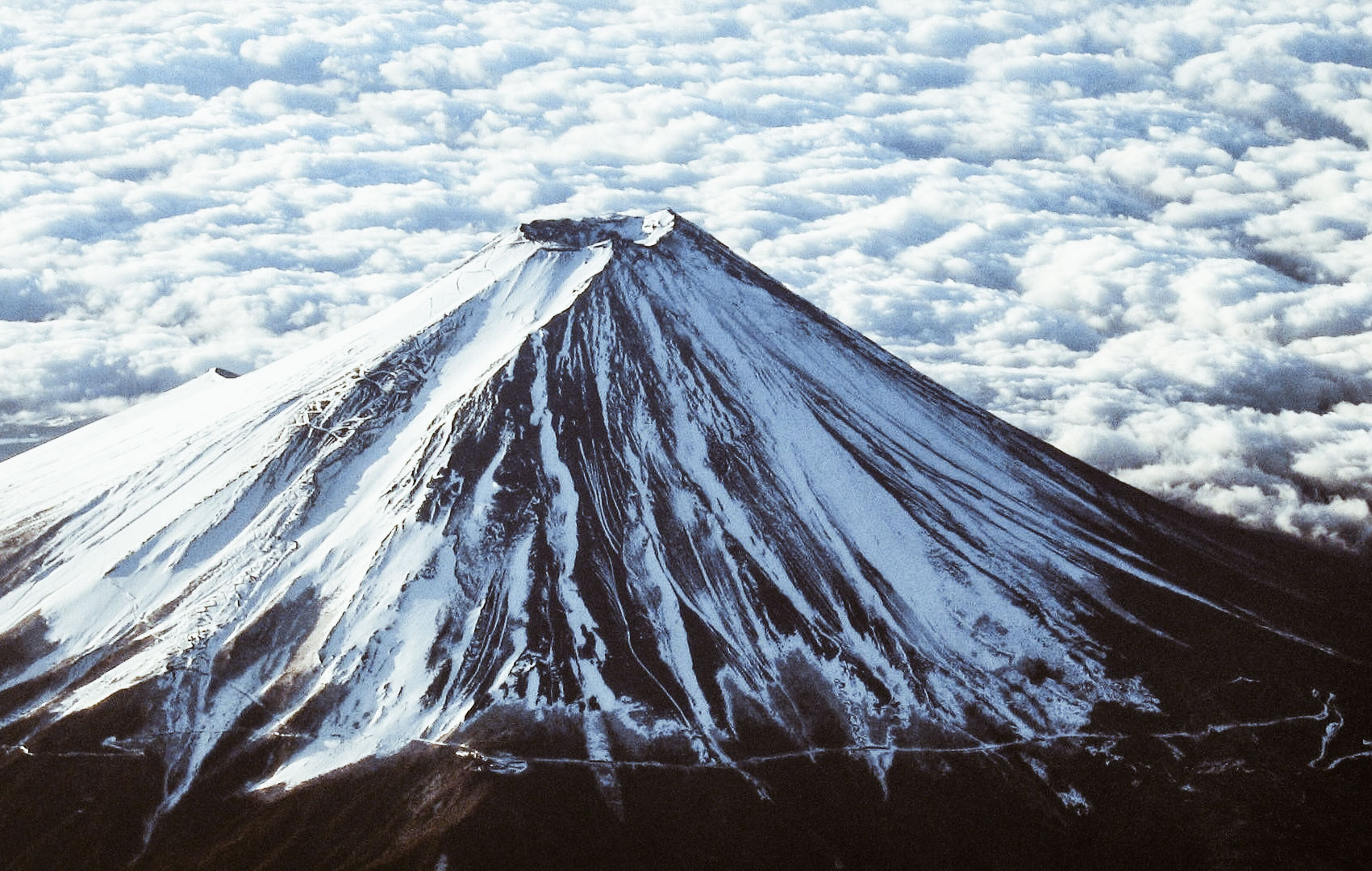
photo credits: linkedin.com
No to the “Bullet Climbing”
When climbing Fuji, it is recommended in any case to arrive at 5ᵃ station and stop there for at least a couple of hours, before resuming the ascent, so that your body can adapt to climate and altitude; to always hydrate a lot, in addition to taking several breaks during the climb. It is always not recommended, even more so for beginners, to try everything during the daytime hours to return at sunset. While starting the ascent early in the morning and taking it easy, it can be tiring. This is demonstrated by the upsurge in sickness following which the Japanese government itself was forced to dissuade itself from practicing “crazy climbs” or Bullet Climbing.
By the way: did you know that until the 19th century women could only climb up to the 2ᵃ station? There, they were made to wait for the return of their male relatives, but they went further. This is because at one time she was not considered capable of withstanding the harsh conditions of the mountain and that this would have hindered the practitioners in isolation. Just think that the first woman to climb Fuji in 1833 disguised as a man! Also from the 19th century, then, the first foreigners on the summit.
When and where to best admire it
The best seasons in which to admire it without the clouds constantly interfering, are always autumn and winter – from November to February. Especially winter, in December and January, which are played out depending on the weather and climate. Some years the visibility is better in December, others in January.
The visibility is not optimal instead between April and August, especially in the months of April, June and July, when it is particularly reduced; but also in September, being the latter period of typhoons.
In short, what is decisive in terms of visibility, more than the weather conditions (a sunny day is not equivalent to good visibility!), are the seasons.
Between late summer and early autumn, then occurs the phenomenon of Fuji Rosso so defined because of the color that the mountain assumes at dawn. Since the period in which it occurs is precisely circumscribed, assisting you is considered a good omen. In particular for business and fertility (it seems that the Japanese see in Red Fuji a woman in a state of interest!). In general, that brings good luck and makes one’s dreams come true.

photo credits: ameblo.jp/ameba20091/
The best time of the day to observe it in full is always in the morning, especially at 8.00 am. The further you go in the day, the less it is visible for the whole day, the better.
From Tokyo it is visible – mist or clouds permitting – especially from: Metropolitan Government Palace in Shinjuku (on the 45th floor, free entrance!), Roppongi Hills, from the iconic Tokyo Tower, but especially from the impressive SkyTree. You can also do it from the 5th floor of Haneda International Airport, open 24 hours a day! Good to know, in case you are waiting for a flight right at dawn…isn’t it?
To keep in mind also the location Miho no Matsubara (三保の松原), historical for the view of Mount Fuji. And, in spring, the spectacle of the “carpet” of Shibazakura, pink moss flowers that cover the meadows at the foot of the mountain. Every year the Shibazakura Festival is celebrated for the occasion (芝桜祭).
You can also get a great view from Mount Takao, 1 hour from Shinjuku, ideal if you have to stay close to Tokyo. Finally, a personal opinion: the view of Fuji rising against the backdrop of the city of Yokohama at sunset is simply wonderful. I could observe it from one of the mini cruises available in the bay.

photo credits: pinterest.it
Share this:
- Click to share on Facebook (Opens in new window)
- Click to share on Twitter (Opens in new window)
- Click to share on Tumblr (Opens in new window)
- Click to share on Pinterest (Opens in new window)
- Click to share on Telegram (Opens in new window)
- Click to share on WhatsApp (Opens in new window)
- Click to share on Reddit (Opens in new window)
- Click to print (Opens in new window)






